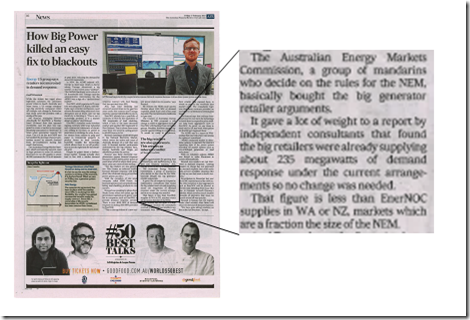Following on from a couple of pretty stressful weeks in the NEM for many affected parties – but particularly for energy users:
1) who will pay higher prices (either straight away if spot exposed, or in the future, if not);
2) who have seen reliability threatened – and in some cases have actually lost supply for a time.
It’s not really a surprise to see a significant amount of press coverage, in the aftermath, about a number of aspects of the crisis – including:
1) What actually happened – and, on this note, we hope that WattClarity is proving of some value;
2) Who was involved (and, for some who like to point fingers, who or what is to “blame”); and
3) A range of “gadgets” (if we loosely term them as such) being promoted by their providers, and their supporters, as potential/partial “solutions” to the crisis.
Demand Response is just one of these – as I have noted over here today on the dedicated demand response site. In particular, I would like highlight this article in the AFR with the provocative title that seems to claim that all of the generators and retailers in the market (presumably including all the innovative start-ups as well) banded together to kill one of these solutions:
Two points I would like to flag here:
1) In the article, the point seems to be made that an assumed amount of demand response active in the NEM (implied at only 235MW) is way lower than that seen in other markets elsewhere. However this number is a gross under-estimation that somehow keeps being repeated:
(a) It seems to imply that the independent consultants employed by the AEMC were somehow conned in their investigation process. For comparison purposes, we’ve linked here what an outline from the consultants (Oakley Greenwood) in terms of what they actually found in relation to the amount of demand response currently active in the NEM.
(b) It’s also substantially lower than the MW rate of consumption represented of clients we serve who operate to supply a form of demand response into the NEM (as we have explained before), with that volume growing in recent times as energy users grow more sophisticated, as some retail energy brokers more educated, and as price volatility increases. And we’re just one company!
2) The tone of this article (and the general push for the adoption of a “negawatt buyback model” as a new form of demand response) seems to be one that pushes the line that incumbency should automatically mean that people can disqualify the submissions of “Big Power” (print above) or “electricity cartel” (online) as invalid. When did this become the case? Is this not forgetting that there are a number of innovative start-ups (including new retailers, and others) operating in the space to make demand response work within existing rules – hence lowering the risk of unintended (or known, but overlooked) consequences.
For those interested in some more of the gory details, beyond the sound bites, note that I have previously written about the rule change process for the negawatt buyback model here in June 2014, and here in November 2015.



Paul
Wattclarity is an amazing source of information
While I might not agree with all of the conclusions reached, the process is clear and the information provided is accurate so we can use it to help us better understand the highly complex NEM
Please keep up the good work
Thanks for keeping it going
David